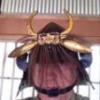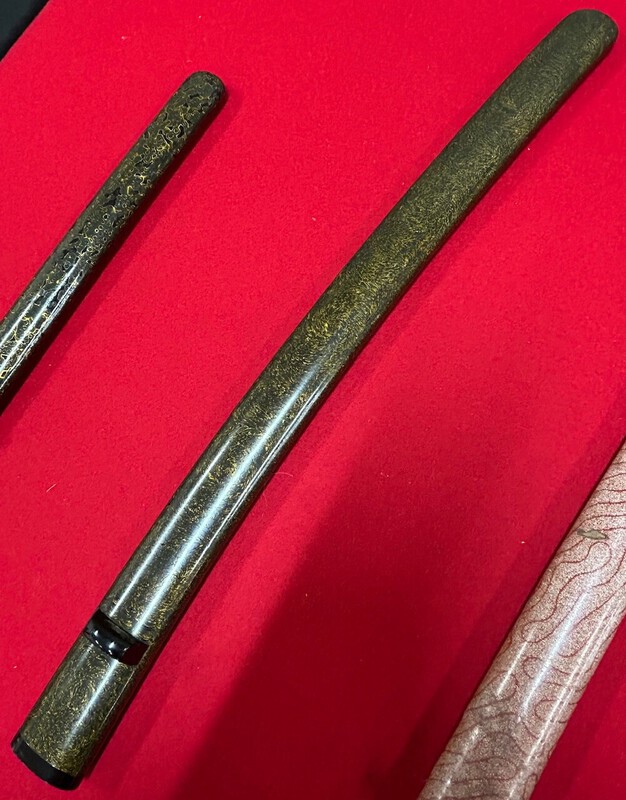-
Posts
14,079 -
Joined
-
Last visited
-
Days Won
260
Content Type
Profiles
Forums
Events
Store
Downloads
Gallery
Everything posted by Bugyotsuji
-
I get what you are saying but we can see Hanabishi for example in both areas. Actually my own sense is that the artisan chose some brass Mon (rimmed) disks almost at random, for the pattern rather than any affiliation.
-
Hi Jake, Here is a Kamon map of southwestern Japan and Kyūshū. I am sure you have consulted such maps already, but please compare this with the area of Kansai and east which follows this post. Kyūshū
-
People often mistakenly compare it with Arlington, as in the post-WW2 letter above, and although of a similar spirit, true, there are no actual bodies or remains interred at Yasukuni Jinja, purely lists of names. Magnificent set, congratulations. Some years ago a friend called me and asked if I could drive his car for him. A strange request indeed. Following his instructions I drove to the riverside. “Watch this!” he said as he pulled out a Nambu, (totally illegal here) and without further ado threw it far out into the river.
-
14 years... JUMP
-

Latest tsuba for a translation query
Bugyotsuji replied to kissakai's topic in Translation Assistance
Correct all that old information now while Nobody San's post is till fresh! -

Single character on brass lock plate
Bugyotsuji replied to Bugyotsuji's topic in Translation Assistance
As an adjunct to this, there is a kamon on the barrel, but since these were often added later I cannot put too much weight on it. The shape is a 蛇の目 Janome, or snake's eye, said to be talismanic; originally this mon depicted the 弦巻 tsurumaki spare cord reel for a bow which hung at the left side by the tachi koshirae. The most famous user of this mon was Kato Kiyomasa, but since he once called Inatomi Ichimu a traitor, I cannot imagine him placing his mon on an Inatomi Ryu gun. There were several families in mid Japan who used the janome, (Kato, Toda, Hori, Ishikawa, Kutsuki, etc.) but all seem to have kept it as their kaemon, i.e. secondary. There was another famous Mitsuyasu branch of the Kato who served under Hideyoshi in Owari and later from 1629 ruled as lords of Ozu Castle in Shikoku. This family used the janome mon as their main 本紋 'Honmon' or 正紋 'Seimon', and kept it throughout Edo, not as a substitute or secondary 'Kaemon', according to a geographical map of Kamon. So if we had to tie all this information together, it could be the material for a small paper! An Inatomi school gun that served the Mitsuyasu branch of the Kato family, possibly made in Owari province in the early to mid-Edo Period. A likely story! Thank you everyone who had a look, showed interest or even participated in this thread! Much appreciated. -

Single character on brass lock plate
Bugyotsuji replied to Bugyotsuji's topic in Translation Assistance
Thanks for that vote, Steve! The scales are now tipping more towards one of those listed 古田 Furuta lockwork makers above, (other readings such as Koden are possible), meaning the gun itself could well have been produced in Owari around mid-Edo, c.1680-1780 ish. “Grrrrrreattttttt!!!” says Tony the Tiger! -
Many Daimyo around Japan used the nine-star Kuyomon, including Date Masamune, but possibly the Hosokawa were the most famous. As to Yamagane, I heard just recently that it is copper extracted 'as is' from a mine, meaning that it includes trace impurities, i.e. it is inconsistent throughout Japan. Suaka by contrast is literally 'pure copper' that has had the impurities removed.
-

Single character on brass lock plate
Bugyotsuji replied to Bugyotsuji's topic in Translation Assistance
(Please excuse the update, but after some research I wish to record my thoughts here while they are still in my mind.) Problem restated Can we read it, and then find a place of manufacture based solely upon this unreadable lockplate character or mark? The school of gunnery is Inatomi Ryu, (also pronounced Inadome) but the gun is unsigned. Guns were made to Inatomi specifications in Kunitomo, Sakai and Owari at least. Checking the matchlock mechanism artisans, there were no likely candidates in Kunitomo, Sakai or Sunpu, but in Owari there were three generations of Furuta with names beginning with Ichi 市, i.e. Furuta Ichirobei (Genroku), Furuta Ichirozaemon (Kyoho) and Furuta Ichizaemon (Tenmei). Ichimu's following generations served in Owari. Gun locksmiths did indeed sometimes sign with a stamp or impression using one character of their name, often the first letter of the individual name, so, one possibility, i.e. that this is Ichi 市, is born, or to some extent borne out here. The famous Inatomi Ichimu 1551-1611 was the eldest son (or grandson?) of Inatomi 祐英 (Sukehide) and was originally named Yojiro, then Sakon, then Iga no Kami Minamoto Sukenao 祐直. His skills in gunnery were noted by many Daimyo who wished to have him teaching close at hand, such as Tokugawa Ieyasu at Sunpu. Notably, the famous swordsmith and gunsmith Hankei (Nihon Kiyotaka) also worked there and produced guns in the Inatomi/Inadome school style. Notice here the Kanji character in the thread's opening post above once more, that no one except Uwe has commented on. Uwe agreed with ネ at first, then possibly 市. But! What if? What if the character stamped on the lockplate above is a construct, an amalgam/amalgamation of the common-to-both character 'Suke' 祐 (ネ and 右) of the father 祐秀Sukehide and the famous (grand) son 祐直 Sukenao, later 'Ichimu'? This could account for the appearance of ネ with a 口 lower right. Hmmm... Or to take this a step further, might the locksmiths have blended their character Ichi 市 with the Suke 祐 of the founders Sukehide and Sukenao? Enough of the brain storming. Here is some background concerning the school of Inatomi/Inadome Ichimu, in English. https://www.japanesewiki.com/person/Sukenao INADOME.html -

Edo Period Corner Part II
Bugyotsuji replied to estcrh's topic in General Nihonto Related Discussion
Point of interest. Asking about the tanto shirasaya and tsunagi, I got a message back saying it should be ready shortly. As to togi though, we face a fine problem. The primary dilemma for the togishi will be how to preserve this blade's sugata throughout any polishing process undertaken. Change the silhouette or geometry, and you could soon have a new kitchen knife. My guess is that previous owner(s) have already agonized on how to best preserve this blade. -
I was thinking yamagane too.
-
You could do both, an internal double-ended screw, plus an outer metal sheath to keep it all straight, then bind with fine cord, and place another similar cord bound section at an equal but opposite location giving it a more balanced look... (?)
-
Such a shame that they have to do this. Sad old world where the laws make life difficult and uncomfortable for everyone, and culture gets abused in the process. What you've done looks like a pretty good fix, you are happy, and you still have the ability to dismantle and travel! (Besides, if you find a better method in the future, that option is till open.)
-
Jiro (but no Taro) Naokatsu. Unless I am missing something, Nobuie is on the front of the tsuba, and the humble artist Jiro who emulated Nobuie has placed himself on the reverse, no?
-
A wire hanger may be too strong, difficult to bend to the right shape, and possibly damaging to the saya. If you do not have the equipment for Brian's approach, Natthaniel's wire idea may be better. Source a section of the right thickness, and play with different shapes of hook. The thing is to do it in your head first, over a day or two, and wait for the answer to crystallize in your brain. You have to work intuitively.
-
Yesterday I attended a lecture on koshirae, the methods and materials used by artisans. It was given in the events hall at the Osafune museum where this exhibition is presently being held. In the room was a large collection of privately-held koshirae spread over the tables for the attendees to handle. One comment struck me about how we think of the samurai being Spartan in their simplicity, but here we have all these gorgeous and flamboyant koshirae, as if rich merchants were wanting to show off their wealth. He gave us examples of some lacquering and embedding processes so time-consuming that no-one today would attempt them. One take-away for me, though, partly to answer your question, Brian, was that almost anything goes. One process, a lacquer swirling pattern for example, involved mixing tofu with the lacquer to slow the drying process. Another koshirae was decorated with what looked like migrating birds, but close examination suggested shark baby teeth. Yet another one had what the experts had declared were ground-down shells embedded into the lacquer, but the owner had determined were the round entrance covers for a shellfish called a 酢貝 Sugai or vinegar shell. (Lunella coreensis.) In other words, although there may be some fleeting acknowledgement of cultural meaning, on the whole artisans and patrons were choosing refreshingly unusual patterns from Nature. Almost as if they were talking points for people living in a rigidly defined static class system. With fish inner ear bones, I am guessing it was solely the rarity factor, almost a game to avoid boredom, "What do you think these are?" that the owner enjoyed inflicting on those who would listen! ’Chidori’ birds?
-
Oli, he said it is signed but he is not going to show us yet. You can see 造, but above that he has blanked it off.
-
This has come up here many times, Walter. Run a search under 'Soten' tsuba.
-
Old kanji 國廣Kunihiro for 国広
-
Grev, according to one book here, he belonged to the 中原 (一派) Nakahara (group) of artisans in Hagi, around Kaei. If so it could well be a nod to his Sensei or working group.
- 1 reply
-
- 1
-

-
Strangely, when I hung up a Noh mask recently, my wife said that the daughters would be scared of it. "No way!", I replied, laughing. Not long after that, separately, both reacted just as my wife had predicted. "Scary!" they said. Not towards the armor, though!
-
BTW, don’t worry if everything is not perfect. You’ll rarely find one in perfect condition, but yours looks as if it has plenty to enjoy. The woodwork has a nice rich colo(u)r. Sakai guns are famous for their bling kirigane metalwork, dividing collectors into those that love this aspect …and all the rest! (I have just come into possession of a rather similar one!) 😊
-

Love when this happens- need signature confirmation help for menuki
Bugyotsuji replied to Mantis dude's topic in Tosogu
You mean Hideoki 秀興, Jack?













